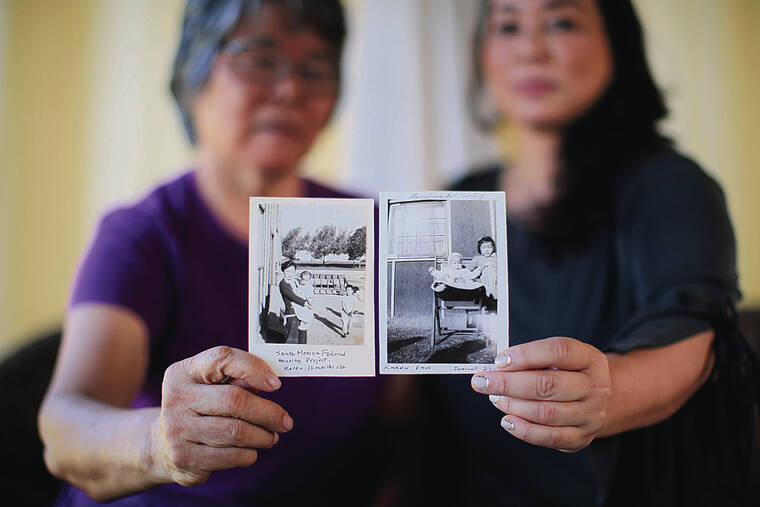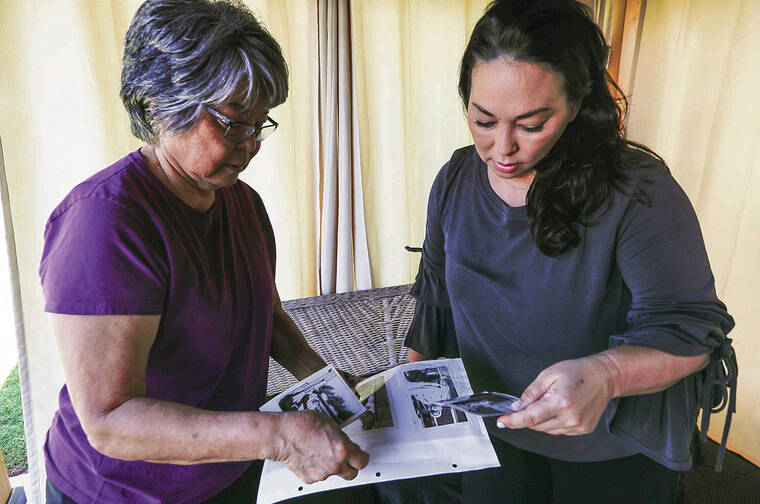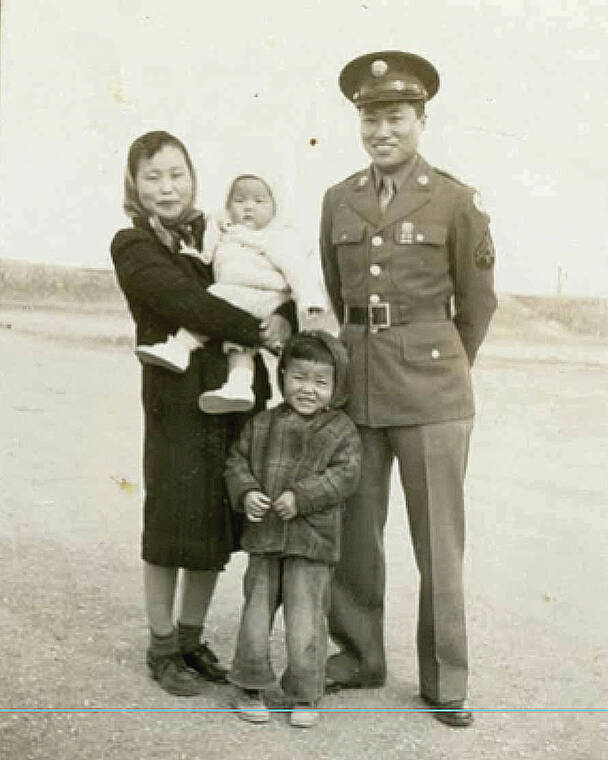Community marks 80th anniversary of Japanese internment with reflection, hope

JAMM AQUINO / JAQUINO@STARADVERTISER.COM
Today marks the 80th anniversary of Executive Order 9066, which allowed for the mass evacuation of many Japanese in Hawaii and on the mainland to internment camps during World War II. Karen Yamaga, left, and daughter Minda hold up photographs of Karen as an infant.

JAMM AQUINO / JAQUINO@STARADVERTISER.COM
Karen Yamaga, left, looked at old photos Thursday with her daughter, Minda, in East Honolulu.

COURTESY YAMAGA FAMILY
Karen’s mother, Kimiko “Mary” Yamaga, left; older sister, Jo Anne; older brother, Roy; and uncle Masashi “Leo” Kunisaki, who enlisted in the Army prior to the Pearl Harbor bombing.



Karen Yamaga spent the first five months of her life at Heart Mountain Relocation Center in Wyoming. Although she doesn’t have memories of time spent at the internment camp, the impact it had on her family during and after World War II was traumatic and long-lasting.
When her family was released from Heart Mountain in October 1945, she said, her parents didn’t want to leave “because they had nothing to go back to.” After moving back to the Los Angeles area, Yamaga, the youngest of three children, said, her father had a difficult time finding work because of the prejudice against Japanese Americans. Also, he was sick with COPD (chronic obstructive pulmonary disease). Her mother found a job working on an assembly line in a warehouse sewing dress sleeves.
For six months the family lived in a trailer park in Santa Monica; they then moved into federal housing for a few months. Yamaga remembers her sister, Jo Anne, who is three years older, took care of her because her mother worked a lot to provide for the family. Her father eventually found work as a shoe repairman.
But the struggles didn’t end there. Yamaga said her older brother, Roy, was bullied and called names by his peers at school.
“It was a very difficult situation. There were no jobs, no property and no money — nothing,” said Yamaga, a retired University of Hawaii professor. “I don’t know how (my family) did it.”
Yamaga, 76, is one of about 122,000 people of Japanese ancestry in Hawaii and on the mainland who were forcibly evacuated from their homes and sent to internment camps after the Pearl Harbor bombing. Today marks the 80th anniversary of Executive Order 9066, which authorized the internment and was issued by President Franklin Roosevelt on Feb. 19, 1942.
Don't miss out on what's happening!
Stay in touch with breaking news, as it happens, conveniently in your email inbox. It's FREE!
Local community leaders, including Yamaga’s daughter, Minda Yamaga of the Japanese American Citizens League Honolulu chapter Opens in a new tab, a civil rights organization that works to challenge racism and bigotry directed against Japanese Americans and the greater Asian American community, say it’s important to not just remember what happened, but to learn from those past injustices.
“There are so many aspects of what was done in 1942 that remain relevant in today’s world,” said Minda Yamaga, JACL Honolulu chapter’s first vice president and president elect.
“That was not, unfortunately, the last racially motivated, unjustified event that has occurred in the United States. These types of injustices need to be remembered so that today in our world we can continue to fight against them recurring.”
After the executive order was issued, people of Japanese ancestry were evacuated, confined, isolated and relocated to 10 sites in six Western states and Arkansas. Nearly 70,000 of them were U.S. citizens. Most of them lost their homes, jobs and properties.
In Hawaii more than 2,000 people of Japanese ancestry were incarcerated, most of whom were community, business and religious leaders suspected of disloyalty. None were ever found guilty of sabotage or espionage. Because the Japanese population made up much of Hawaii’s workforce, government officials deemed it infeasible to send all of them to internment camps.
Some Hawaii internees were sent to the mainland, while others were sent to detention centers in the islands. The largest and longest-used confinement site in Hawaii was at Hono‘uli‘uli Opens in a new tab. Opened in March 1943, the 160-acre site held both civilians and prisoners of war. It contained 175 buildings, 14 guard towers and more than 400 tents. Many internees referred to Honouliuli as Jigoku-Dani, “hell valley,” because the gulch was hot and isolated.
Hanako Wakatsuki-Chong, Honoʻuliʻuli National Historic Site superintendent, said more needs to be done to educate people about the internment. Four generations of her family were incarcerated at Manzanar War Relocation Center in California. Her father, the fifth of eight children, was the first of his siblings born outside of the camp after the war ended. Her great-aunt Jeanne Wakatsuki Houston wrote the memoir “Farewell to Manzanar.”
When she was a child, Wakatsuki-Chong said, her family, like many other Japanese Americans, didn’t talk about their experiences during and after the war. She said she remembers asking her grandmother about camp, and getting few answers.
“As a child I was a little disappointed. I thought it was because she didn’t remember,” she said. “But as an adult, and as I’ve been studying this history, I realized that she didn’t want to talk to me about it. I didn’t realize how traumatizing it was for her.”
While many of their families were interned and faced prejudice, more than 30,000 Japanese Americans served in the military. Many were part of the 100th Infantry Battalion, 442nd Regimental Combat Team, Military Intelligence Service and 1399th Engineer Construction Battalion, which were all made up of mostly second-generation Japanese American, or nisei, men. The 100th and 442nd RCT became the most decorated unit for its size and length of service in U.S. military history.
After the war ended, most internment camps closed in 1945. But that wasn’t the end of racism or bigotry.
Wakatsuki-Chong said her grandfather, who served in the Army, couldn’t find a job because of prejudice. So, she said, “he put aside his pride and became a wrestler” to support his family.
It wasn’t until many years later that the government issued a formal apology.
The Civil Liberties Act of 1988 — passed by Congress and signed into law by President Ronald Reagan — acknowledged and apologized for the “fundamental injustice of the evacuation, relocation and internment” and stated that it was “motivated largely by racial prejudice, wartime hysteria and a failure of political leadership.”
As part of the act, the Office of Redress Administration was established to provide restitution payments of $20,000 to eligible internees. The 10-year program provided redress to more than 82,219 people totaling about $1.6 billion.
As part of the redress efforts, government officials worked closely with community organizations. Among them was the JACL Honolulu chapter. Bill Kaneko, a former JACL Honolulu chapter president, said the efforts reached hundreds of families in Hawaii and often involved answering questions, providing pro bono legal services and setting up workshops.
In addition to those who were interned, Kaneko said, about 1,500 to 2,000 people of Japanese ancestry in Hawaii were forcibly removed from their homes but not interned. They were families who lived close to sensitive military bases or installments, and were told by the government to leave but were given no housing alternatives, he said.
Kaneko, whose father-in-law was one of those evacuees, said those families were also eligible for redress.
“That was probably one of the most invigorating times. We had to fight for their rights. There were a handful of us who basically took on the Department of Justice,” he said. “What an opportunity for us as sansei (third- generation Japanese Americans), who reaped the benefits of education and our parents working hard, to give back to the community.”
Karen Yamaga, who moved to Hawaii in 1980 and worked for three decades as a UH microbiology professor, said prior to traveling back to Heart Mountain in 2017 with daughter Minda Yamaga and her extended ohana, she knew little about her family history.
There she heard from other internees, who shared their experiences during and after the war. Minda Yamaga said that trip provided a “really deep and profound connection to our past.”
Since then, Minda Yamaga said, the JACL has met with Congress members to discuss ways to combat anti- Asian hate, while also advocating for other marginalized communities.
“What my mom instilled in me was to have a career that means something to the world you’re in. I assume some of those values were deeply sprouted from the experiences they had and struggles they overcame,” she said.
“We hope that (this anniversary) can be educational, and more people find awareness and also inspiration for how we can do better moving forward and look toward places where we can find healing and come together.”
>> The JACL Honolulu chapter is holding a free virtual event to commemorate the 80th anniversary today at 5 p.m. Go to bit.ly/3FnpS0h Opens in a new tab for more information.
>> The National Park Service, in conjunction with other groups, is also hosting a National Day of Remembrance virtual event, which began Friday and runs through Sunday. Visit americanhistory.si.edu/day-of-remembrance Opens in a new tab.
———
Jayna Omaye covers ethnic and cultural affairs and is a corps member of Report for America, a national service organization that places journalists in local newsrooms to report on undercovered issues and communities.



